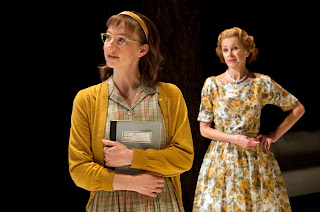As part of the recent OFF-MIRVISH Second Stage Series, Anthony Rapp's one man musical show is a virtuoso theatrical event that pulls at the heartstrings and gives audiences an intimate glimpse of the now historic development of the groundbreaking musical RENT. With disarming candor, a powerful and beautiful singing voice, and a knack for poignant and funny vocal characterizations of those closest to him, Rapp moves seamlessly through an eighty minute elegiac tribute to two of the most significant individuals in his life - his mother and Jonathan Larson.
Larson's tragic death is now a part of musical theatre history, and Rapp gives his audience a personal glimpse into the period when Larson was beginning to see his dream come true, with Rapp as one of a large extended family of gifted artists who became part of the internationally acclaimed hit based on the opera La Boheme. Using songs by REM as well as numbers from RENT, Rapp connects the events of his life over the past two decades through song and storytelling in a moving, funny, and thoroughly engaging manner.
A five piece band has a spectacular finale as Rapp closes the show - and brings the audience to its feet - with Larson's memorable Season's of Love. Lighting by Tim Mascall gives the bare stage a powerful theatricality that beautifully punctuates the simplicity this one man tour-de-force embodies. By simply speaking to his audience in a direct and honest way, Rapp has been able to create a universal message about love and loss and ways in which to move through those life events with both sadness and joy. The show is a tribute to family of all kinds, with significant nods to the ways in which queerness has become, with the aid of shows like RENT and artists like Anthony Rapp and Jonathan Larson, an iconic site for a very special kind of enduring community building among the disenfranchised and the musically blessed.
http://www.mirvish.com/pages/offmirvish
Mirvish Productions launches a series of acclaimed new productions from our own community, local productions of award-winning international new plays and original productions of new works from the world festival circuits.
Larson's tragic death is now a part of musical theatre history, and Rapp gives his audience a personal glimpse into the period when Larson was beginning to see his dream come true, with Rapp as one of a large extended family of gifted artists who became part of the internationally acclaimed hit based on the opera La Boheme. Using songs by REM as well as numbers from RENT, Rapp connects the events of his life over the past two decades through song and storytelling in a moving, funny, and thoroughly engaging manner.
A five piece band has a spectacular finale as Rapp closes the show - and brings the audience to its feet - with Larson's memorable Season's of Love. Lighting by Tim Mascall gives the bare stage a powerful theatricality that beautifully punctuates the simplicity this one man tour-de-force embodies. By simply speaking to his audience in a direct and honest way, Rapp has been able to create a universal message about love and loss and ways in which to move through those life events with both sadness and joy. The show is a tribute to family of all kinds, with significant nods to the ways in which queerness has become, with the aid of shows like RENT and artists like Anthony Rapp and Jonathan Larson, an iconic site for a very special kind of enduring community building among the disenfranchised and the musically blessed.
WITHOUT YOU RUNS FROM Dec 13, 2012 to Jan 6, 2013
AT THE PANASONIC THEATRE
651 Yonge Street,Toronto, ON M4Y 1Z9 416 872-1212
Jonathan Larson (February 4, 1960 – January 25, 1996)
http://www.mirvish.com/pages/offmirvish
Mirvish Productions launches a series of acclaimed new productions from our own community, local productions of award-winning international new plays and original productions of new works from the world festival circuits.
The inaugural series is composed of TERMINUS from Outside the March theatre company, Anthony Rapp’s Edinburgh Fringe Festival hit WITHOUT YOU, the multi-award-winning CLYBOURNE PARK from Studio 180 Theatre, and Mary Walsh’s new show DANCING WITH RAGE.


























